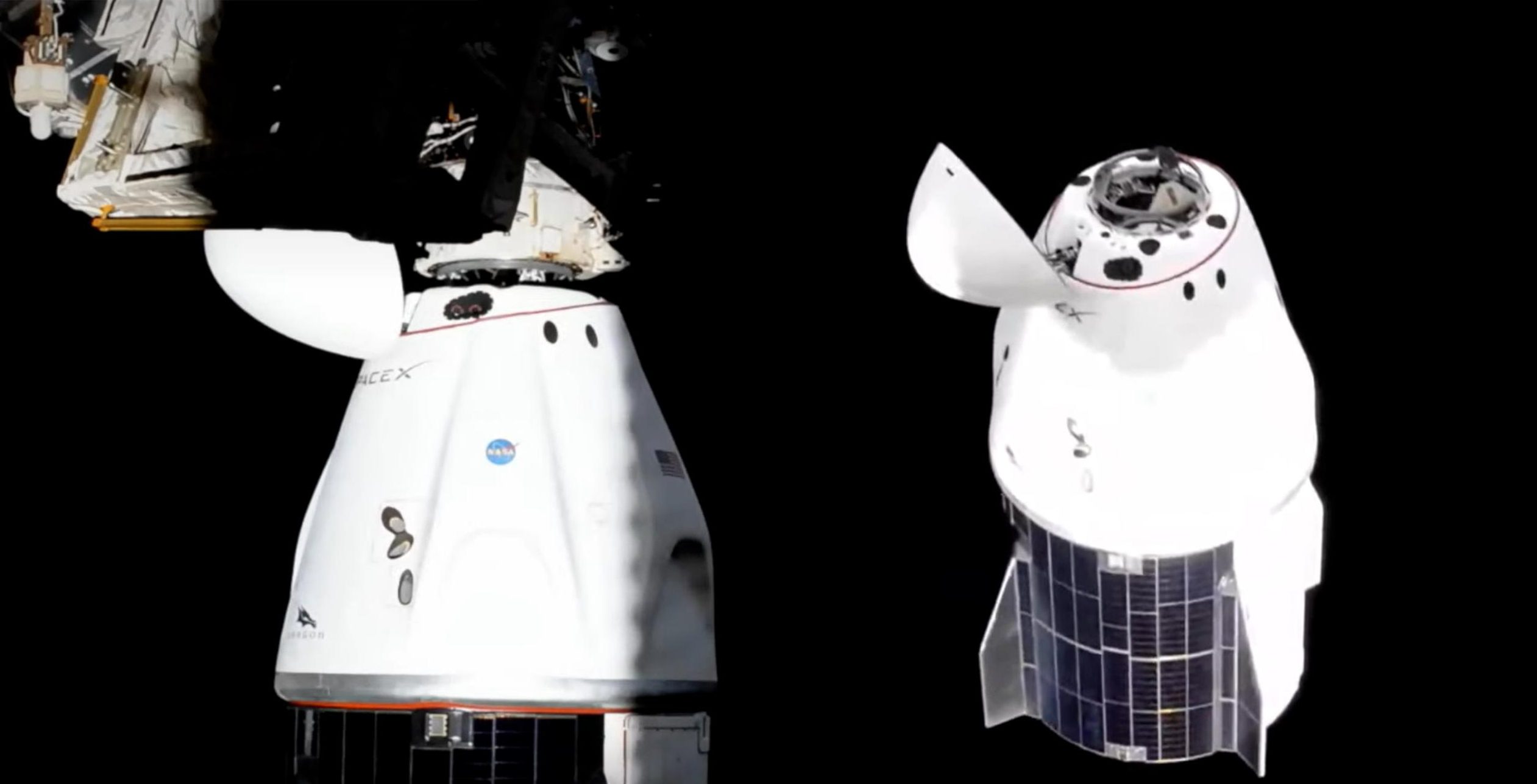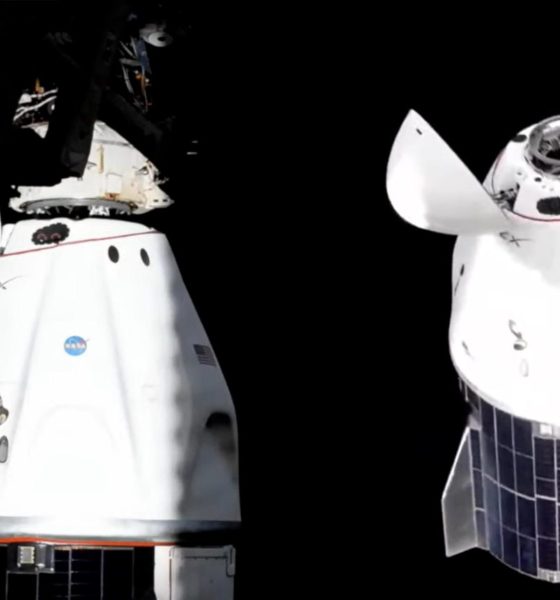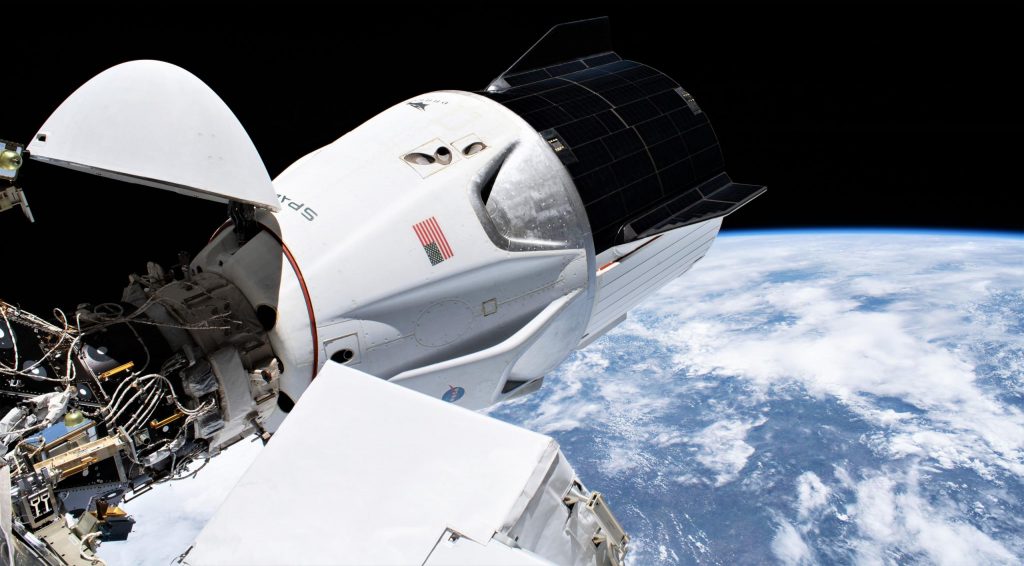

News
SpaceX Crew Dragon switches ports to make room for Boeing’s Starliner do-over
Update: For the second time, a SpaceX Crew Dragon spacecraft has successfully swapped International Space Station (ISS) docking ports in orbit – this time to make way for Boeing’s planned Starliner Orbital Test Flight do-over.
If Starliner’s second orbital flight test is more successful than the first, which failed almost immediately after launch, the Boeing spacecraft will launch no earlier than July 30th, rendezvous and dock with the ISS, and spend approximately five days at the station before attempting to return to Earth. Once Starliner departs, freeing up the forward docking port, SpaceX and NASA will likely have to perform a second Crew-2 port relocation, moving Dragon back to its original port to set the stage for the CRS-23 Cargo Dragon resupply mission scheduled in late August.
SpaceX and NASA are on track for the Crew-2 Dragon spacecraft currently docked to the International Space Station (ISS) to perform a “port relocation” maneuver early Wednesday, effectively opening the door for Boeing’s Starliner flight test do-over.
Scheduled to launch on a United Launch Alliance (ULA) Atlas V rocket no earlier than (NET) July 30th, Boeing’s Starliner will be flying for the first time since the spacecraft’s near-catastrophic Orbital Flight Test (OFT) debut in December 2019. During Starliner’s inaugural test flight, a combination of inept Boeing software development, shoddy quality control, and inexplicably lax NASA oversight allowed the spacecraft to launch with inoperable software.
As a result, things went wrong mere seconds after Atlas V – which performed nominally – deployed Starliner. Almost as simple as using the wrong clock, the first software fault – something that would have been instantly caught with even the most rudimentary integrated systems test – caused Starliner to think it was in a different part of the OFT mission and waste much of its fuel with thousands of unnecessary thruster firings.
Aside from pushing Starliner’s maneuvering thrusters beyond their design limits, those unplanned and unexpected misfirings also threw the spacecraft off course, obfuscating Boeing and NASA’s ability to communicate and command the spacecraft and troubleshoot the situation at hand. Eventually, the company regained control of Starliner, but not before it had burned through most of its propellant reserves – precluding plans for to rendezvous and dock with the ISS.
Less than three hours before reentry, Boeing also uncovered a separate thruster-related software issue that could have caused the Starliner capsule to lose stability and re-impact its expendable trunk section after separation.
Ultimately, with so many issues and a failure to gather any kind of data related to operations at and around the ISS, NASA thankfully forced Boeing to plan to repeat OFT with Orbital Flight Test 2 (OFT-2). Scheduled to launch in December 2020 as of the second half of that year, OFT-2 ultimately slipped – both for scheduling and technical reasons – to March, June, and finally July 30th, 2021.

More than 19 months after Starliner’s ill-fated debut, NASA and Boeing are now almost ready for the spacecraft’s critical do-over. For unknown reasons, though, NASA and/or Boeing apparently need (or prefer) Starliner to use a specific docking port – the same port SpaceX’s second operational Crew Dragon spacecraft is currently docked to. According to NASA and Boeing, Starliner needs to use that forward docking port because it has not been qualified for zenith docking, which is a bit more complex. As a result, SpaceX and NASA have scheduled a port relocation maneuver around 7am EDT (UTC-4) on Wednesday, July 21st.
SpaceX’s first relocation occurred in early April to prepare for the arrival of a second Crew Dragon later that month. When Crew-1 Dragon departed a few weeks after the maneuver, it would leave the station’s zenith (space-facing) port free for a Cargo Dragon 2 spacecraft scheduled to arrive around one month later. Due to the station’s geometry and port layout, only the zenith port allows its robotic Canadarm2 arm to unload unpressurized cargo from Dragon’s trunk.
Already at the forward port, the Crew-2 Dragon will thus be moving to the zenith port for Starliner’s brief 1-2 week stay at the ISS. However, as may have become clear, Crew Dragon will then have to re-relocate to the forward port for any future Cargo Dragon missions – one of which happens to be scheduled to launch with an important unpressurized payload as early as August 29th.
Regardless of why, it’s hard to ever complain about seeing Dragons fly. Tune in around 6:30 am EDT (10:30 UTC) to watch Crew Dragon C206 maneuver around an orbital space station.

News
Tesla aims to combat common Full Self-Driving problem with new patent
Tesla writes in the patent that its autonomous and semi-autonomous vehicles are heavily reliant on camera systems to navigate and interact with their environment.

Tesla is aiming to combat a common Full Self-Driving problem with a new patent.
One issue with Tesla’s vision-based approach is that sunlight glare can become a troublesome element of everyday travel. Full Self-Driving is certainly an amazing technology, but there are still things Tesla is aiming to figure out with its development.
Unfortunately, it is extremely difficult to get around this issue, and even humans need ways to combat it when they’re driving, as we commonly use sunglasses or sun visors to give us better visibility.
Cameras obviously do not have these ways to fight sunglare, but a new patent Tesla recently had published aims to fight this through a “glare shield.”
Tesla writes in the patent that its autonomous and semi-autonomous vehicles are heavily reliant on camera systems to navigate and interact with their environment.

The ability to see surroundings is crucial for accurate performance, and glare is one element of interference that has yet to be confronted.
Tesla described the patent, which will utilize “a textured surface composed of an array of micro-cones, or cone-shaped formations, which serve to scatter incident light in various directions, thereby reducing glare and improving camera vision.”

The patent was first spotted by Not a Tesla App.
The design of the micro-cones is the first element of the puzzle to fight the excess glare. The patent says they are “optimized in size, angle, and orientation to minimize Total Hemispherical Reflectance (THR) and reflection penalty, enhancing the camera’s ability to accurately interpret visual data.”
Additionally, there is an electromechanical system for dynamic orientation adjustment, which will allow the micro-cones to move based on the angle of external light sources.
This is not the only thing Tesla is mulling to resolve issues with sunlight glare, as it has also worked on two other ways to combat the problem. One thing the company has discussed is a direct photon count.
CEO Elon Musk said during the Q2 Earnings Call:
“We use an approach which is direct photon count. When you see a processed image, so the image that goes from the sort of photon counter — the silicon photon counter — that then goes through a digital signal processor or image signal processor, that’s normally what happens. And then the image that you see looks all washed out, because if you point the camera at the sun, the post-processing of the photon counting washes things out.”
Future Hardware iterations, like Hardware 5 and Hardware 6, could also integrate better solutions for the sunglare issue, such as neutral density filters or heated lenses, aiming to solve glare more effectively.
Elon Musk
Delaware Supreme Court reinstates Elon Musk’s 2018 Tesla CEO pay package
The unanimous decision criticized the prior total rescission as “improper and inequitable,” arguing that it left Musk uncompensated for six years of transformative leadership at Tesla.

The Delaware Supreme Court has overturned a lower court ruling, reinstating Elon Musk’s 2018 compensation package originally valued at $56 billion but now worth approximately $139 billion due to Tesla’s soaring stock price.
The unanimous decision criticized the prior total rescission as “improper and inequitable,” arguing that it left Musk uncompensated for six years of transformative leadership at Tesla. Musk quickly celebrated the outcome on X, stating that he felt “vindicated.” He also shared his gratitude to TSLA shareholders.
Delaware Supreme Court makes a decision
In a 49-page ruling Friday, the Delaware Supreme Court reversed Chancellor Kathaleen McCormick’s 2024 decision that voided the 2018 package over alleged board conflicts and inadequate shareholder disclosures. The high court acknowledged varying views on liability but agreed rescission was excessive, stating it “leaves Musk uncompensated for his time and efforts over a period of six years.”
The 2018 plan granted Musk options on about 304 million shares upon hitting aggressive milestones, all of which were achieved ahead of time. Shareholders overwhelmingly approved it initially in 2018 and ratified it once again in 2024 after the Delaware lower court struck it down. The case against Musk’s 2018 pay package was filed by plaintiff Richard Tornetta, who held just nine shares when the compensation plan was approved.
A hard-fought victory
As noted in a Reuters report, Tesla’s win avoids a potential $26 billion earnings hit from replacing the award at current prices. Tesla, now Texas-incorporated, had hedged with interim plans, including a November 2025 shareholder-approved package potentially worth $878 billion tied to Robotaxi and Optimus goals and other extremely aggressive operational milestones.
The saga surrounding Elon Musk’s 2018 pay package ultimately damaged Delaware’s corporate appeal, prompting a number of high-profile firms, such as Dropbox, Roblox, Trade Desk, and Coinbase, to follow Tesla’s exodus out of the state. What added more fuel to the issue was the fact that Tornetta’s legal team, following the lower court’s 2024 decision, demanded a fee request of more than $5.1 billion worth of TSLA stock, which was equal to an hourly rate of over $200,000.
Delaware Supreme Court Elon Musk 2018 Pay Package by Simon Alvarez
News
Tesla Cybercab tests are going on overdrive with production-ready units
Tesla is ramping its real-world tests of the Cybercab, with multiple sightings of the vehicle being reported across social media this week.

Tesla is ramping its real-world tests of the Cybercab, with multiple sightings of the autonomous two-seater being reported across social media this week. Based on videos of the vehicle that have been shared online, it appears that Cybercab tests are underway across multiple states.
Recent Cybercab sightings
Reports of Cybercab tests have ramped this week, with a vehicle that looked like a production-ready prototype being spotted at Apple’s Visitor Center in California. The vehicle in this sighting was interesting as it was equipped with a steering wheel. The vehicle also featured some changes to the design of its brake lights.
The Cybercab was also filmed testing at the Fremont factory’s test track, which also seemed to involve a vehicle that looked production-ready. This also seemed to be the case for a Cybercab that was spotted in Austin, Texas, which happened to be undergoing real-world tests. Overall, these sightings suggest that Cybercab testing is fully underway, and the vehicle is really moving towards production.
Production design all but finalized?
Recently, a near-production-ready Cybercab was showcased at Tesla’s Santana Row showroom in San Jose. The vehicle was equipped with frameless windows, dual windshield wipers, powered butterfly door struts, an extended front splitter, an updated lightbar, new wheel covers, and a license plate bracket. Interior updates include redesigned dash/door panels, refined seats with center cupholders, updated carpet, and what appeared to be improved legroom.
There seems to be a pretty good chance that the Cybercab’s design has been all but finalized, at least considering Elon Musk’s comments at the 2025 Annual Shareholder Meeting. During the event, Musk confirmed that the vehicle will enter production around April 2026, and its production targets will be quite ambitious.








